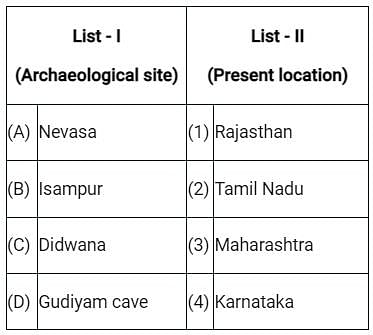Banking Exams Exam > Banking Exams Tests > Test: Ancient History - Banking Exams MCQ
Test: Ancient History - Banking Exams MCQ
Test Description
10 Questions MCQ Test - Test: Ancient History
Test: Ancient History for Banking Exams 2024 is part of Banking Exams preparation. The Test: Ancient History questions and answers have been prepared
according to the Banking Exams exam syllabus.The Test: Ancient History MCQs are made for Banking Exams 2024 Exam.
Find important definitions, questions, notes, meanings, examples, exercises, MCQs and online tests for Test: Ancient History below.
Solutions of Test: Ancient History questions in English are available as part of our course for Banking Exams & Test: Ancient History solutions in
Hindi for Banking Exams course.
Download more important topics, notes, lectures and mock test series for Banking Exams Exam by signing up for free. Attempt Test: Ancient History | 10 questions in 10 minutes | Mock test for Banking Exams preparation | Free important questions MCQ to study for Banking Exams Exam | Download free PDF with solutions
Test: Ancient History - Question 1
Which of the following statements about the Harappan script is not correct?
Detailed Solution for Test: Ancient History - Question 1
Detailed Solution for Test: Ancient History - Question 2
| 1 Crore+ students have signed up on EduRev. Have you? Download the App |
Test: Ancient History - Question 3
Match list-I with list-Il and choose the correct answer using the code given below the lists


Detailed Solution for Test: Ancient History - Question 3
Test: Ancient History - Question 4
Which Veda depicts the information about the most ancient Vedic age culture?
Detailed Solution for Test: Ancient History - Question 4
Test: Ancient History - Question 5
The dockyard was found in which of the following sites of Indus valley civilization?
Detailed Solution for Test: Ancient History - Question 5
Test: Ancient History - Question 6
Kalinga's King Kharvela was associated with which of the following dynasty?
Detailed Solution for Test: Ancient History - Question 6
Test: Ancient History - Question 7
In the Rigvedic Dasrajan Yudha (Battle of Ten Kings) the Bharatas emerged winner at the bank of __?
Detailed Solution for Test: Ancient History - Question 7
Test: Ancient History - Question 8
Which among the following dynasties were ruling over Magadha when Alexander invaded India?
Detailed Solution for Test: Ancient History - Question 8
Test: Ancient History - Question 9
Which among the following major rock edicts of Ashoka are in Kharosthi script?
Detailed Solution for Test: Ancient History - Question 9
Detailed Solution for Test: Ancient History - Question 10
Information about Test: Ancient History Page
In this test you can find the Exam questions for Test: Ancient History solved & explained in the simplest way possible.
Besides giving Questions and answers for Test: Ancient History, EduRev gives you an ample number of Online tests for practice
Download as PDF

















